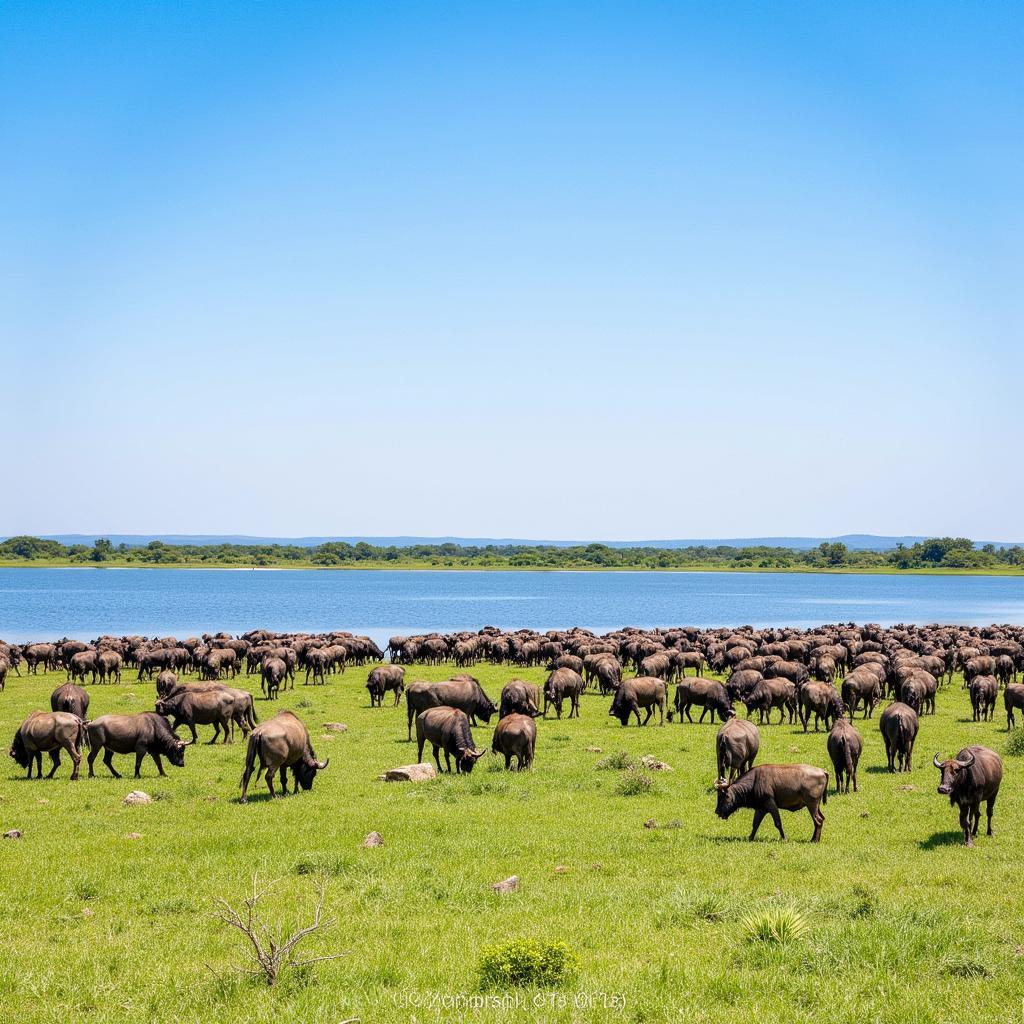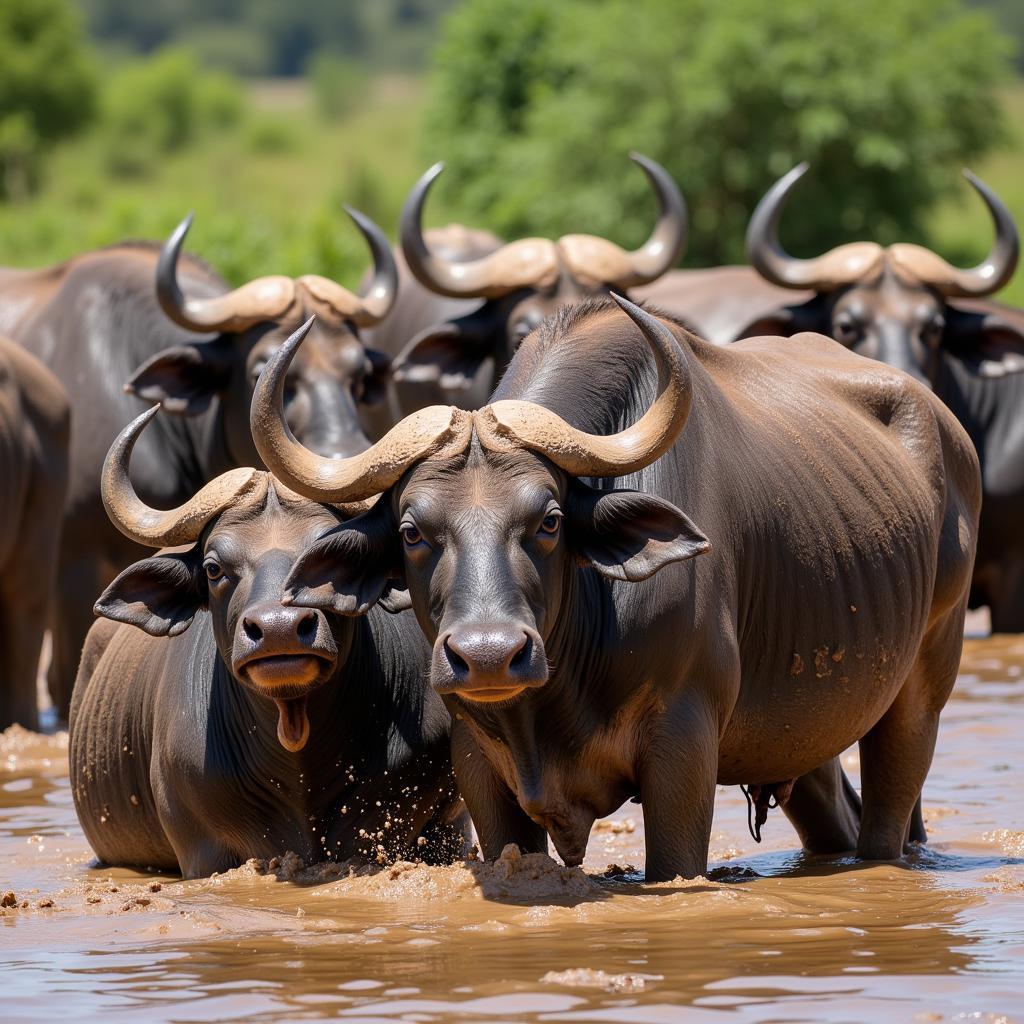African Buffalo in Lake Nakuru: A Majestic Sight
Lake Nakuru National Park, a breathtaking expanse in the heart of Kenya, offers a wildlife spectacle like no other. And among its many residents, the African buffalo stands out as a symbol of raw power and resilience. These massive herbivores, often seen grazing in their hundreds near the lake’s shores, are a sight to behold, their presence adding to the unique tapestry of this incredible ecosystem.
Unveiling the Giants: African Buffalo at Lake Nakuru
Imagine standing at the edge of the vast, shimmering Lake Nakuru. A gentle breeze ruffles the water, and in the distance, you spot them: a herd of African buffalo, their dark forms silhouetted against the golden grasslands. They seem almost prehistoric, with their massive, curved horns and powerful builds, a testament to the enduring force of nature.
 African buffalo grazing near Lake Nakuru
African buffalo grazing near Lake Nakuru
These aren’t solitary creatures; they thrive in herds that can number in the hundreds, sometimes even thousands. Their sheer size and strength offer them protection from predators, creating a mesmerizing spectacle of collective power. Witnessing them graze, their horns occasionally clashing as they establish dominance, is a glimpse into the intricate social dynamics of these fascinating animals.
More Than Just a Pretty Picture: The Buffalo’s Role
The presence of African buffalo in Lake Nakuru isn’t just about visual splendor; it speaks to a deeper ecological balance. As grazers, they play a crucial role in shaping the landscape, their feeding habits influencing the growth and diversity of vegetation. This, in turn, affects the entire food web, from the smallest insects to the apex predators.
 African buffalo wallowing in a mud pool at Lake Nakuru
African buffalo wallowing in a mud pool at Lake Nakuru
Their relationship with the lake is particularly significant. Their grazing habits near the shoreline prevent the encroachment of certain plant species, helping to maintain the delicate balance of the lake’s ecosystem. This balance is crucial, as Lake Nakuru is world-renowned for its vibrant flamingo populations, a testament to the interconnectedness of life within the park.
Witnessing the Wild: Experiencing the Buffalo in Lake Nakuru
Observing African buffalo in their natural habitat is an experience that stays with you. Whether you’re a seasoned wildlife enthusiast or a first-time visitor to Africa, seeing these creatures up close is awe-inspiring. The park offers a variety of ways to experience the buffalo, from guided game drives to walking safaris, each offering a unique perspective on these magnificent creatures.
But it’s not just about the buffalo. Lake Nakuru National Park is a treasure trove of biodiversity. From the millions of flamingos that paint the lake pink to the elusive leopards that roam its forests, the park offers a breathtaking tapestry of life. And at the heart of it all, the African buffalo stands as a symbol of the wild beauty and ecological significance that makes this place so special.
FAQs about African Buffalo in Lake Nakuru
Q: What is the best time of year to see African buffalo in Lake Nakuru?
A: While buffalo can be seen year-round, the dry season (June to October) is generally considered the best time for wildlife viewing in Lake Nakuru. During this period, the vegetation is less dense, making it easier to spot animals.
Q: Are African buffalo dangerous?
A: Yes, African buffalo are wild animals and should be treated with respect. They are known to be unpredictable and can be dangerous, especially if they feel threatened. It is crucial to maintain a safe distance and observe them from the safety of a vehicle during game drives.
Q: What is the average lifespan of an African buffalo?
A: The average lifespan of an African buffalo in the wild is around 15-20 years.
Q: What do African buffalo eat?
A: African buffalo are herbivores, and their diet primarily consists of grass. They are grazers and can consume up to 50 kilograms of grass per day.
Q: What predators do African buffalo have?
A: Adult African buffalo have few predators due to their size and strength. However, lions, leopards, and hyenas may prey on calves or injured individuals.
Q: Can I go on a walking safari to see the African buffalo in Lake Nakuru?
A: While walking safaris are possible in Lake Nakuru, it is not recommended to approach African buffalo on foot. They are powerful and unpredictable animals, and it is best to observe them from a safe distance in a vehicle.
For more information on planning your African family holiday destinations and experiencing the wonders of Lake Nakuru’s wildlife, feel free to explore our other resources or contact us directly. We’re here to help you plan your unforgettable African adventure.
Need help planning your trip to see the magnificent African buffalo in Lake Nakuru? Contact us!
Phone: +255768904061
Email: kaka.mag@gmail.com
Address: Mbarali DC Mawindi, Kangaga, Tanzania.
Our dedicated team is available 24/7 to assist you.
